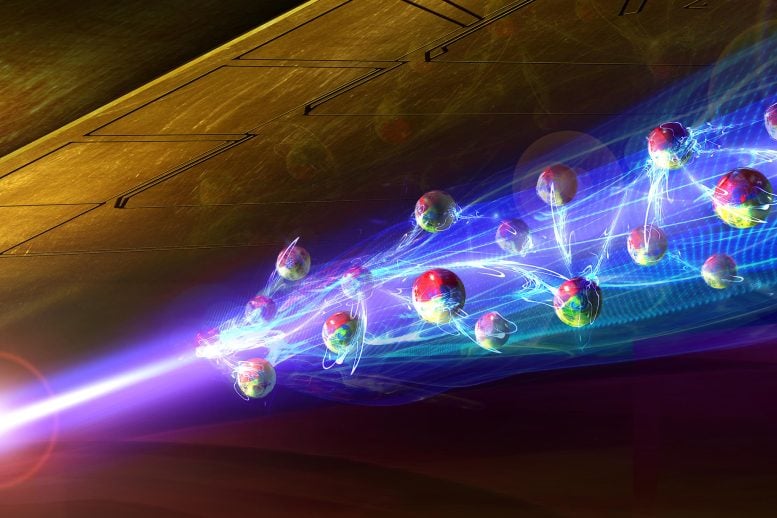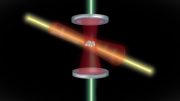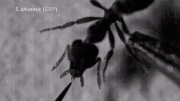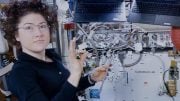
The atoms are polarized by the beam of light and start to attract each other. Credit: Harald Ritsch / TU Wien
Atoms may be made to attract one another using light.
Theoretically, this effect has been predicted for a very long time. However, the Vienna Center for Quantum Science and Technology (VCQ) at Vienna University of Technology, in collaboration with the University of Innsbruck, has now measured this exotic atomic bond for the first time. This interaction can be used to manipulate atoms that are incredibly cold, and the effect may also have a role in how molecules form in space. The findings were recently published in Physical Review X.
A positive and negative charge
A positively charged atomic nucleus is surrounded by negatively charged electrons in an electrically neutral atom, which surrounds the atomic nucleus like a cloud. “If you now switch on an external electric field, this charge distribution shifts a little,” explains Professor Philipp Haslinger, whose research at the Atominstitut at Vienna University of Technology is supported by the FWF START program. “The positive charge is shifted slightly in one direction, the negative charge slightly in the other direction, the atom suddenly has a positive and a negative side, it is polarised.”
Because light is just an electromagnetic field that changes extremely quickly, this polarization effect may also be achieved with laser light. When many atoms are located near one another, the laser light polarizes them all precisely in the same manner, either with positive on the left and negative on the right, or the other way around. Both times, two neighboring atoms move their opposing charges in the direction of one another, creating an attractive force.
Experiments with the atom trap
“This is a very weak attractive force, so you have to conduct the experiment very carefully to be able to measure it,” says Mira Maiwöger from Vienna University of Technology, the first author of the publication. “If atoms have a lot of energy and are moving quickly, the attractive force is gone immediately. This is why a cloud of ultracold atoms was used.”
The atoms are first captured and cooled in a magnetic trap on an atom chip, a technique, which was developed at the Atominstitut in the group of Professor Jörg Schmiedmayer. Then the trap is switched off and releases the atoms in free fall. The atom cloud is ‘ultracold’ at less than a millionth of a Kelvin, but it has enough energy to expand during the fall. However, if the atoms are polarized with a laser beam during this phase and thus an attractive force is created between them, this expansion of the atomic cloud is slowed down – and this is how the attractive force is measured.
Quantum laboratory and space
“Polarising individual atoms with laser beams is basically nothing new,” says Matthias Sonnleitner, who laid the theoretical foundation for the experiment. “The crucial thing about our experiment, however, is that we have succeeded for the first time in polarising several atoms together in a controlled way, creating a measurable attractive force between them.”
This attractive force is a complementary tool for controlling cold atoms. But it could also be important in astrophysics: “In the vastness of space, small forces can play a significant role,” says Philipp Haslinger. “Here, we were able to show for the first time that electromagnetic radiation can generate a force between atoms, which may help to shed new light on astrophysical scenarios that have not yet been explained.”
Reference: “Observation of Light-Induced Dipole-Dipole Forces in Ultracold Atomic Gases” by Mira Maiwöger, Matthias Sonnleitner, Tiantian Zhang, Igor Mazets, Marion Mallweger, Dennis Rätzel, Filippo Borselli, Sebastian Erne, Jörg Schmiedmayer and Philipp Haslinger, 27 July 2022, Physical Review X.
DOI: 10.1103/PhysRevX.12.031018









… now I know how do …
From accretion disks to quantum spins, countless facts show that the interaction of vortex fields is indispensable in the formation and evolution of cosmic matter. The mathematics has also clearly told us that the topological vortex field can evolve into a complex space-time structure from the cusp singularity. However, contemporary physics has always regarded understanding as confused. Starting from the top-level design, it has developed into pseudoscience with impunity. Wrong world outlook and scientific outlook may mislead a generation, even several generations. If there is no physical environment with dark matter and dark energy topological vortexes, there can be neither all kinds of celestial bodies and microscopic particles nor the interaction of them. If you are interested, you can browse https://zhuanlan.zhihu.com/p/569722770.